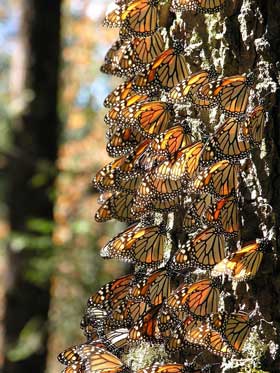Monarch Butterfly Biology
Life Cycle
The monarch butterfly, like other insects, has several life forms and stages prior to reaching adulthood. The monarch has four distinct life stages: egg, larva (caterpillar), pupa (chrysalis), and adult.

Photos: Egg by William Zittrich; Larva by USDA; Pupa by William Zittrich; Adult by Tanya Harvey.
The Migrating Generation

Monarchs congregating on a tree at El Rosario Sanctuary, Michoacan, Mexico. Photo by Sue Sill, LCHPR, Inc.
During the summer breeding season, monarchs live from 2-5 weeks during which they mate and lay the eggs that become the next generation. The last generation of the year does not become reproductive and is said to be in “reproductive diapause”. These butterflies are the ones that migrate to Mexico where they overwinter. These butterflies become reproductive in February and March as they move north, laying eggs on milkweeds as they progress northward into the United States. Some of these butterflies can live as long as 9 months!
The migratory generation has an enormous task ahead of them. Weighing less than a gram, these unique butterflies will fly between 2,000 to 3,000 miles to an overwintering location in Mexico.
Monarchs have up to four generations each summer, each one traveling a little further north than the last. The last generation of the year migrates south.

